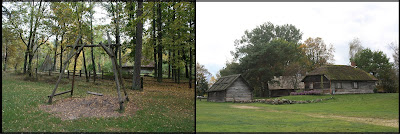As you get your ticket (only 1.50 Ls with student discount), you can also ask for a free map. When receiving the map and looking at the back, you can already read some information about the museum,
as shown below between brackets.
'The Ethnographic Open-Air Museum of Latvia was established in 1924. Nowadays 118 folk architecture objects and more than 3000 household items from all Latvian historical and ethnographical regions (Kurzeme, Latgale, Vidzeme, Zemgale), along with evidence of the way of life and culture of the rural population, characteristic to the period from the 17th century until 40-ies of the 20th century, are exhibited in the territory of 87ha on the coast of Jugla Lake in Riga. The museum researches, exhibits as a whole and promotes the monuments of traditional life, as well as educates and informs the society about the cultural heritage, work and daily life traditions and aesthetics of folks who had lived in the territory of Latvia''
There are 5 entrances, but we got in at the entrance close to the Museum Administration (where we bought our ticket). From here, the first thing you will see at your left is the Roadside inn (Zemgale, Vecumnieki, 1841; 1938). This is a very dark shed (most other objects are (very)) dark too - used flash for making photo's)) with various wooden items, most being vehicles or vehicle related.
 Still in the same shed you can find the souvenir shop and a bar, although the latter seemed to be
Still in the same shed you can find the souvenir shop and a bar, although the latter seemed to bemostly for private use, or having to be reserved for groups beforehand. As for the souvenir shop, they have quite a good offering.
 When moving on you will come across the 2nd object on the map, the hut for water-pump.
When moving on you will come across the 2nd object on the map, the hut for water-pump.''Built in the first half of the 19th century in the city of Kuldiga. Among the museum exhibits since 1936. For many years it had been set at the crossing where it had supplied people with water. At the museum the pump raises water from the depth of ten metres.''
19th c: 1940)
''Put up in 1907 in the village of Dirbeli, parish of Bebrene in the former district of llūkste (present district of Daugavpils). Exhibited since 1984. This was in keeping with ancient catholic traditions that crucifixes were put up in the villages, at the churches and along the roads. Prayers were said and sacred songs were sung there.''
Object 8, not being far away, is a Dweling house (Rucava, ''Vēcķērves'', about 1848; 2001).
There are 14 Dwelling houses related objects on the premises of the museum, of which 12 are Dwelling houses and 2 are Dwelling house-workshops.
4 objects further, we reach object 12, Smithy (Kurzeme, Mērsrags, about 1880: 1953).
''A building from fishermen's village at Mērsrags, former Talsi district (present Talsi district) dating back to the 2nd half of the 19th century. Brought to the museum in 1951 together with its equipment consisting of forge, bellows, anvil, hammers, tongs, etc. Various tools and household utensils were made in the smithy, horses were shoed, and even arms were forged there in 1905.''
 Also wanting to reflect on the earliest exhibit of the museum, we move our feet to object 110 (Lutheran church, Zemgale (Augšzeme), Kaplavas Vecborne, early 16th c; 1937)
Also wanting to reflect on the earliest exhibit of the museum, we move our feet to object 110 (Lutheran church, Zemgale (Augšzeme), Kaplavas Vecborne, early 16th c; 1937)''Built in the first half of the 16th century in the village of Vecborne, parish of Kaplava in the former district of llūkste. Exhibited since 1936. This church is the earliest exhibit of the museum and the only wooden church that has survived to the present day from the first half of the 16th century.''
Now, there is also a Dutch wind-mill at the museum, which draw my attention because I am Dutch also, wanting to check if it really looks like a Dutch windmill from back home.
I can say, it probably does, but I am of course no expert.
Some pictures in- and outside the windmill.
I was also able to make a picture of the framed legenda, below you can see part of it (click image to view in full size).

Even if you are not so much interested in the technical details, or history, you can still walk around in the Latvian Ethnographic Open Air Museum to simply let your mind come to rest and enjoy the nature.
I mean, simply look at these wonderful flowers!









Geen opmerkingen:
Een reactie posten